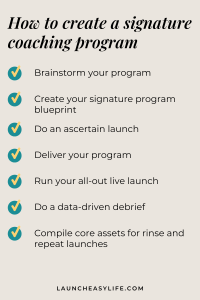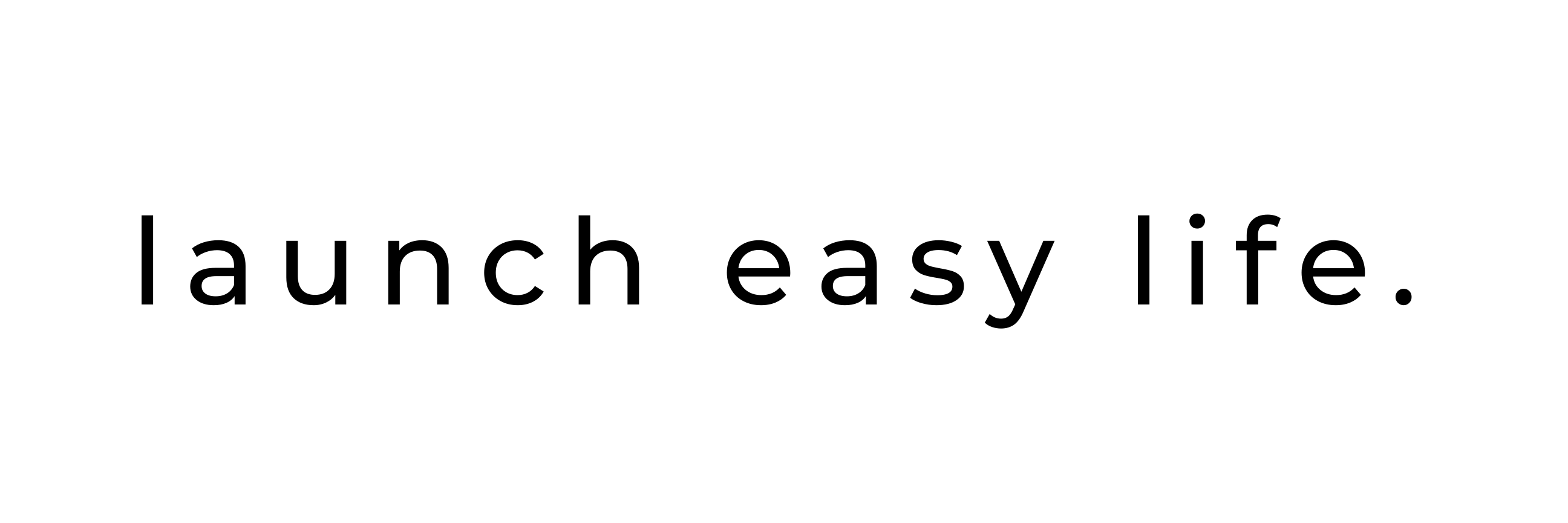Are you dreaming of creating a profitable business in part-time hours with predictable revenue? Whether you want to spend more time with your family, travel more, or grow a multi-million dollar business, a signature program is my best recommendation for how to achieve this. In this guide, you’ll learn how to create a signature coaching program that helps bring your vision to life.
Signature programs have allowed me to take holidays whenever I want, show up for my children, renovate our house – and so much more. And now it’s your turn. Below, I’ll share steps and examples for creating a 100K signature program – the same process I teach in my Peace + Profit Mastermind
What is a signature coaching program?
A signature coaching program is a structure or system that you can reuse to support an unlimited number of clients – often called a 1:many program.
A signature program is the hero of your business. It’s a unique flagship program that serves your target audience and offers a specific and substantial outcome for a specific type of person at a specific point in time. You can launch your program multiple times with a rinse-and-repeat framework for recurring revenue, which untethers your time from your earnings.
Moving from 1:1 coaching to a signature coaching program
While 1:1 coaching can be helpful when starting out – allowing you to get to know your people, develop a consistent formula, and start earning money – it’s not a sustainable way to grow your business.
With 1:1 coaching, your revenue will likely tap out at around $5k per month, even though it feels like you’re always working. I know because I’ve been there – and even quit my business until I realized how to create peace in my business while working six hours per week and earning a six-figure revenue.
Look at it this way: let’s say you have a goal to reach $100,000 annual revenue in your business and that you sell single sessions for $120 per session. This means you’ll be running 833 sessions per year or 17 sessions per week (48 weeks of the year). This – on top of endless admin tasks – is energetically exhausting.
Creating a signature program lets you:
- Have more time flexibility
- Take on an unlimited # of clients
- Simplify how you help people
- Become known for one thing
- Automate or eliminate large parts of your business, like discovery calls
How to move from 1:1 coaching to a signature coaching program
If you’re offering 1:1 coaching and want to step away, you’ll want to first increase your prices and create a runway for your signature coaching program.
When you raise your prices, you may lose a few clients, but that’s okay because you’ll earn more from the ones who stay and free up time for you to work on other things. Clients willing to pay premium prices are usually prepared to do the work for the best results, and that’s a win-win.
Balancing your expenses and building a revenue runway of three to six months gives you time to create and warm up your audience with your new business model. With a runway, you remove the pressure to instantly switch from 1:1 coaching to your signature program. Instead, you can use this time to invest in creating your signature program.
How to create a signature coaching program
I’ve helped dozens of coaches, practitioners, and service providers create a signature program using the following steps. It’s what I teach in my Peace + Profit program, which helps established service providers, consultants, and course creators scale to multi-six figures in part-time hours. This is also the same process to generate more than $150,000 in the first 18 months from my own signature program.

Brainstorm your program
The first step to creating your coaching program is brainstorming at a basic level. If you’ve already had 1:1 clients, you may already have a clear idea for your program.
Think: what do you find yourself repeating to your clients? What’s the timeline or framework you walk them through to get results? After working with clients in a 1:1 capacity, most 1:1 coaches will find themselves in this place. If this is where you’re at, it’s time to leverage your time and revenue into a Signature Program.
If you haven’t worked with 1:1 clients before, that’s okay. You can create your program right away, and the steps are essentially the same. Whether you’re a seasoned 1:1 coach or consultant or just starting out – your program will continue to evolve and change with you and the market.
When brainstorming your program, consider the following:
- What problem can you help people solve?
- What transformation can you offer?
- Who’s the program for?
- How long would it take someone to get results if they put in the work?
- Are there any other relevant requirements?
I like to teach my clients to consider their Zero to Hero Transformation to truly resonate with a specific audience. You can do this by identifying: “I help [who] go from [zero] to [hero] with/without [ooohh/ughhh].” For example, if you’re a fertility coach, the transformation you offer might be, “I help women trying to get pregnant go from nonstop crying to calm and confident during their fertility journey without having to meditate for hours every day.”
Create your signature program blueprint
When you first create your signature program blueprint, you develop this for your initial launch. Consider this your first draft, as you can make changes as you beta test the program and get feedback.
When creating your signature program blueprint, map out the following:
- Your transformation – This should be a realistic and specific idea of what you can help your clients achieve. Answer: what will people walk away with when they’ve finished the program?
- Your program name and tagline – Focus more on making this clear, not clever. The name and tagline together should highlight who the offer is for, the transformation, and what makes it unique.
- Module topics – What would it take for someone to get from Zero to Hero – or see the transformation? Jot down every idea you have, then see if you can remove any that would still get them from Zero to Hero. Then, determine what’s essential for the program, if any of these topics can be grouped together, if any can be their own offer or upsell, and if there’s a logical flow.
- Program organization – Organize your topics into modules, bonuses, and upsells – and give each a name and specific transformation.
When creating your blueprint, keep in mind that the program should be 4 to 12 modules/weeks, and each module should be five minutes to one hour.
Do an ascertain launch
Your ascertain launch – also known as a pilot or beta launch – allows you to ascertain demand and ensure that your audience is willing to pay for the program. This usually takes a couple of weeks or long enough to make four to eight sales.
For the ascertain launch, you’ll try to sell the program to a small number of beta testers to ascertain demand and get feedback as you create the program. Your beta testers are usually your warmest audience, which can be former clients, social media followers, or other people you know who may find your program helpful.
When you do your ascertain launch, you won’t bring in significant income – but that’s okay. The ascertain launch ensures you create a signature or coaching program that solves a specific problem your ideal clients desperately want to fix.
The ascertain launch can help you create hype for your program and get real-time feedback from beta testers. If you run an ascertain launch and don’t make sales, you’ll be able to make improvements for the next time around. And the good news is that you won’t invest a bunch of time into creating your program before this launch.
Deliver your program
Once you have a few beta testers, you can deliver the program in a live, group coaching format. Delivering your program live allows you to make tweaks as you go and get real-time feedback about improvements.
You can create your program content as you go based on feedback. Creating the content as you go allows you to avoid procrastinating (you’ll have to create the content since you’ve made the sales!) It also lets you incorporate the feedback you’re receiving from the beta testers.
The program content you’ll create may include:
- Presentation slides/lessons
- Case studies
- Workbooks with exercises
- Assessments
Run your all-out live launch
Now that you’ve delivered your first cohort and created your program, it’s time for your all-out live launch. This is usually a 60 to 90-day process where you build out other assets you can reuse for future sales. These assets may include your sales page, conversion event, and pre-launch runway that helps you generate strong leads.
Launching – especially in the current market – isn’t just about opening the doors and saying, ‘Hey, doors are open, buy my program!’ It’s about creating a runway that supports your target audience in understanding how your program takes people from zero to hero (the transformation you offer) and why they want to take action to make the transformation.
For example, you may know you can solve a specific problem for your ideal clients, who might desperately want that. But it takes less energy for people to stay stuck than to take action. Therefore, your launch process needs to help people see that now is the time to fix their problem – and you can do this with social media and email marketing, an effective sales page, and a conversion event (like a webinar or challenge).
Do a data-driven debrief
A data-driven debrief lets you improve your program and marketing before the next launch.
During your debrief, you can look at:
- Client objection
- Email open rates
- Conversion rates
- Webinar data
- Other marketing information
With this information, you can identify areas for improvement. For example, say your webinar show-up rate and replay watch is low, but the people who watch it convert at a high percentage. You can have your next launch focus more on improving the number of people who watch the webinar to help increase sales.
Compile core assets for rinse and repeat launches
As soon as you finish your launch, I recommend putting together a report and then compiling all your emails, social posts, and other launch materials into one place using a tool like Asana or Google. This lets you rinse and repeat your launch with ease.
Creators often burn out from live launching their signature program because they’re creating their sales pages and other assets from scratch for every launch or scrambling at the last minute to find and put everything together.
Organizing everything can allow you to rinse and repeat every 90 days or so for quick, successful launches.
Additional resources for creating a signature coaching program
As a multi-six-figure business owner who only works 16 hours per week, I know how impactful signature programs can be for success. My superpower is helping women in business create and launch programs without having to work endless hours.
If you’d like more support creating your signature program, you might find these resources helpful:
- Tools and tech – My little black book of tech, suppliers, and software to help you launch your program and scale your online business with ease
- Signature Online Course Secrets – My podcast for female coaches, consultants, and service providers who want to grow and scale a profitable, part-time business
- Peace + Profit Mastermind – An intimate, 6-month program for established female service providers, consultants, and course creators ready to double their revenue while working 20 hours or less per week
